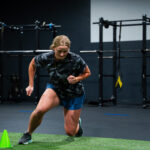Speed and Agility Training for Multi-Sport Athletes
Multi-sport athletes need to be fast, agile, and adaptable. Whether you’re switching between football and baseball or balancing basketball with track, your body has to move in different ways—all year long.
Speed and agility training helps bridge those gaps. It builds transferable athletic qualities like reaction time, lateral movement, and quick direction changes—skills that benefit every sport you play.
Let’s explore how multi-sport athletes can use speed and agility training to stay sharp and perform their best in any season.
The Unique Needs of Multi-Sport Athletes
Unlike single-sport athletes, multi-sport athletes face different movement demands depending on the season. One month you’re sprinting down a court, the next you’re cutting on grass or reacting to a fastball.
Speed and agility training helps by:
-
Improving coordination across sports
-
Enhancing muscular balance
-
Preventing burnout from sport-specific overload
-
Supporting faster adaptation to each new season
According to the NSCA, athletes who train multiple motor patterns throughout the year experience more well-rounded development and fewer overuse injuries.
Key Elements to Focus On
To be effective, speed and agility training for multi-sport athletes should focus on universal athletic skills:
1. Acceleration and First-Step Quickness
Fast starts are valuable in every sport. Think stealing bases, chasing rebounds, or returning kicks.
2. Deceleration and Control
Stopping with control prevents injuries. It also improves balance when changing directions.
3. Lateral Movement and Agility
Side-to-side movement helps in basketball, football, tennis, and beyond.
4. Reactive Decision Making
Drills that involve responding to a cue (visual or auditory) mimic real game scenarios.
5. Multi-Planar Movement
Training in different directions (forward, backward, diagonal) builds total-body control.
Top Drills for Multi-Sport Speed and Agility
Ladder + Cone Combo
Use a ladder followed by 2–3 cones. After fast footwork, break into a short sprint or lateral cut.
-
Benefits: Enhances foot speed and directional change.
-
Progression: Add a reactive signal for direction change.
Reaction Ball Drop
Have a partner drop a reaction ball. Sprint to catch it after one bounce.
-
Focus: Reactive quickness and hand-eye coordination.
-
Tip: Use different starting positions (standing, seated, prone).
Diagonal Crossover Sprints
Sprint diagonally across a square pattern, emphasizing crossover steps.
-
Skills trained: Angled speed, crossover footwork.
-
Use: Mirrors movement patterns from basketball and lacrosse.
3-Point Direction Drill
Set up 3 cones in a triangle. Start in the center and respond to a coach’s cue to sprint to one of the cones.
-
Improves: Decision-making under pressure.
-
Variation: Use numbers, colors, or hand signals as cues.
Lateral Bound and Sprint
Perform a lateral bound, land, and immediately explode into a 10-yard sprint.
-
Purpose: Transitions explosive power into forward speed.
-
Relevance: Great for football, track, and field athletes.
Weekly Training Plan for Multi-Sport Athletes
A smart schedule helps avoid overload and keeps athletes fresh. Here’s a sample weekly layout:
| Day | Focus | Duration |
|---|---|---|
| Monday | Acceleration + Lateral Drills | 30 min |
| Wednesday | Reaction + Control | 25 min |
| Friday | Combo Drills + Conditioning | 35 min |
Rotate drills weekly to target all movement skills and avoid monotony.
Tips for Coaches and Athletes
-
Avoid sport-specific overload. If an athlete just finished basketball season, don’t only use basketball-style drills.
-
Keep intensity high but volume low. Short sessions with maximum focus work best.
-
Train movement variety. Don’t get stuck in a single direction or movement type.
-
Use partner drills. They add fun and simulate real competition.
-
Track improvements. Use stopwatch times or reps to measure progress and boost motivation.
For structured programming, Next Level Athletics offers custom training for multi-sport athletes at all levels.
Long-Term Benefits of Multisport Speed Training
Speed and agility training supports:
-
Reduced injury risk
-
Improved sport-to-sport transition
-
Faster learning of sport-specific skills
-
Increased overall athleticism
It also helps keep athletes mentally engaged and physically well-rounded. As specialization becomes more common, training like a multi-sport athlete gives you a long-term edge.
Conclusion: One Body, Many Sports—Train for All
Your body doesn’t know if you’re playing soccer or basketball—it just knows how to move. That’s why speed and agility training is the perfect tool for multi-sport athletes. It builds fast, responsive movement that translates to every field or court.
Add a few sessions each week, and you’ll stay one step ahead—no matter what sport is in season.


Recent Comments